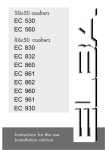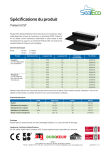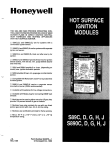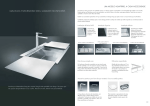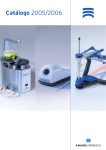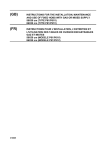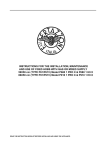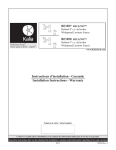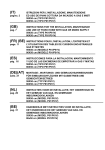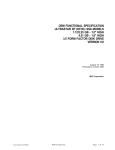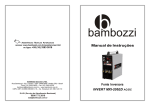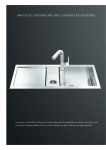Download Elba Gas Cookers Specifications
Transcript
50x50 cooker EC 530 86x50 cooker EC 830 Instruction for the use Installation advice Dear Customer, Thank you for having purchased and given your preference to our product. The safety precautions and recommendations reported below are for your own safety and that of others. They will also provide a means by which to make full use of the features offered by your appliance. Please preserve this booklet carefully. It may be useful in future, either to yourself or to others in the event that doubts should arise relating to its operation. This appliance must be used only for the task it has explicitly been designed for, that is for cooking foodstuffs. Any other form of usage is to be considered as inappropriate and therefore dangerous. The manufacturer declines all responsibility in the event of damage caused by improper, incorrect or illogical use of the appliance. 2 USEFUL HINTS FIRST USE THE OVEN It is advised to follow these instructions: – Clean the interior of the oven with cloth soaked in water and detergent (neutral), then dry carefully. After removing the appliance from its packing, make sure of its integrity. In case of doubt, please apply to your supplier or to a qualified engineer. The packing materials (plastic bags, polyfoam, nails, metal strips etc.) must be moved away from the reach of the children as potential sources of danger. – Insert shelves and tray. – Do not attempt to alter the technical features of the appliance as this may result very dangerous. – Switch on the empty oven on max to eliminate grease tracks from the heating elements. – Do not allow the appliace to be operated by children or disabled without overseeing. – Do not carry out any operation of cleaning or maintenance without prior disconnection of the appliance from the electric supply. – Whenever you decide to get rid of this appliance (in case of replacement with a new one), before scrapping it is recommended to render it inoperative and harmless in respect of health and antipollution regulations. 3 1 - COOKING HOBS EC 530 2 1 3 4 Fig. 1.1 2 1 3 4 Fig. 1.2 GAS COOKING HOBS (Fig. 1.1- 1.2) GENEREAL FEATURES: 1. 2. 3. 4. 4 Auxiliary burner (A) - 900 W Semi-rapid burner (SR) - 1550 W Rapid burner (R) - 2550 W Double-ring burner (DR) - 3500 W EC 830 2 - CONTROL PANEL EC 530 5 EC 830 5 Fig. 2.1 1 2 3 4 6 Fig. 2.2 1 2 3 4 6 CONTROLS DESCRIPTION - (Figs. 2.1, 2.2) 1. 2. 3. 4. 5. 6. Rear left burner control knob Front left burner control knob Front right burner control knob Rear right burner control knob Gas oven control knob Gas burners electric igniter control button (cooktop) 5 3 - USE OF THE HOB BURNERS Each burner is controlled by a gas tap assuring the opening and the closing of the gas supply. Make the symbols printed on the knob to match with the indicator on the control panel, to obtain: ● : off - symbol - symbol : full on (nominal rate) - symbol : reduced rate LIGHTING OF TOP BURNERS WITH ELECTRIC IGNITION - To light the burner turn the knob (fig. 3.1) corresponding to the specific burner to the maximum flame position (large flame symbol) and press the ignition button marked by the symbol ★ (fig. 3.2). If the electronic ignition does not work make sure that the battery, installed on the back of the cooker, is not flat and has been installed correctly (see the chapter “Battery installation”, page 11). The sparks produced by the electrodes situated next to the burner will light the selected burner. In the event that the local gas supply conditions makes it difficult to light the burner in maximum aperture position, try again with the knob in minimum position. - To reduce the gas flow to minimum, rotate the knob further anti-clockwise to point the indicator towards the small flame symbol. Fig. 3.1 - The maximum aperture position permits rapid boiling of liquids, whereas the minimum aperture position allows slower warming of food or maintaining boiling conditions of liquids. - Other intermediate operating adjustments can be achieved by positioning the indicator between the maximum and minimum aperture positions, and never between the maximum aperture and closed positions. Fig. 3.2 Attention: The cooktop becomes very hot while in operation. Keep children away. 6 N.B. When the cooker is not being used, set the gas knobs to their closed positions and also close the cock valve on the gas bottle or the main gas supply line. CHOICE OF THE BURNER On the control panel, near every knob, there is a diagram that indicates which burner is controlled by that knob. The suitable burner must be chosen according to the diameter and the capacity used. As an indication, the burners and the pots must be used in the following way: CORRECT USE OF DOUBLE-RING BURNER The flat-bottomed pans are to be placed directly onto the pan-support. To use the WOK you need to place the proper stand in order to avoid any faulty operation of the double-ring burner (Fig. 3.4a - 3.4b) DIAMETERS OF PANS WHICH MAY BE USED ON THE HOBS BURNERS MINIMUM MAX. Auxiliary 12 cm 16 cm Semirapid 16 cm 20 cm Rapid 20 cm 24 cm Double-ring 24 cm 26 cm wok max 36 cm WRONG It is important that the diameter of the pot be suitable to the potentiality of the burner so as not to compromise the high output of the burners and therefore energy waste. A small pot on a large burner does not give you a boiling point in a shorten amount of time since the capacity of heat absorption of a liquid mass depends on the volume and the surface of the pot. Fig. 3.4a CORRECT Fig. 3.3 Fig. 3.4b 7 4 - GAS OVEN The glass of the oven door reaches high temperatures during operation. Keep children away. GENERAL FEATURES The oven is furnished completely clean; it is advisable, however, upon first use, to turn the oven on to the maximum temperature (position 10) for about 15 minutes to eliminate possible traces of grease from the oven burner. The gas oven, according to the model, is provided with one burner: – Oven burner, mounted on the lower part of the oven (wattage: 3200 W) The cooker lid must be kept open when the gas oven is in use. OVEN BURNER It carries out normal “oven cooking”. The gas flow to the burner is regulated by a thermostat which allow to maintain the oven temperature constant. The control of the temperature is assured by a thermostatic probe positioned inside the oven. The probe must be always kept in its housing, in a clean condition, as an incorrect position or encrustment may cause an alteration in the control of the temperature. THERMOSTAT The numbers 1 to 10 printed on the knob (fig. 4.1) indicate the increasing oven temperature value (see table 4.2). The thermostatic tap controlling the gas supply to the burner is equipped with a safety device which automatically stops the gas flow in case of flame extinction. The temperature is constantly maintained on the set value. Table 4.2 THERMOSTAT GRADE TABLE Thermostat indicator 0 1 0 2 3 4 1 5 6 7 8 9 Fig. 4.1 8 1 2 3 4 5 6 7 8 9 10 Oven temperature 150 165 180 195 210 225 240 255 270 285 °C °C °C °C °C °C °C °C °C °C IGNITION OF THE OVEN BURNER ATTENTION: Never turn the thermostat tap before approaching a flame to the hole “A” of the floor. To light the burner, you need to: 1 – Open the oven door to the full extent. 2 – Press in the oven control knob (fig. 4.1) and turn counter-clockwise to position 10. Keep the knob pressed. 3 – To light the oven approach a flame to the hole “A” of the floor (fig. 4.3). 4 – After lighting the burner, wait a few seconds before releasing the knob (until the safety valve stays open). 5 – Gently close the oven door and set the oven control knob to the required temperature. If the flame extinguishes for any reason, the safety valve will automatically shut off the gas supply to the burner. To re-light the burner, first turn the oven control knob to position ●, wait for at least 1 minute and then repeat the lighting procedure. A Fig. 4.3 OVEN COOKING Before introducing the food, preheat the oven to the desired temperature. For a correct preheating operation, it is advisable to remove the tray from the oven and introduce it together with the food, when the oven has reached the desired temperature. Check the cooking time and turn off the oven 5 minutes before the theoretical time to recuperate the stored heat. For orientative purposes only, some oven cooking indications are shown on the following table: THERMOSTAT POSITION DISHES 1 Heating of foods 1 Meringue - Fruit pies Cooked fruit 1-2 Cakes - Amaretti, Vegetables 2-3 Lasagna - Cakes 3-4 Roast veal - Pie crusts 5-6 Wild game - Birds Small fish - Roast pork 6-7 Large fish Roast beef 7-8 Pizza - Red meats 8-9 Toasted sandwiches 10 Oven cleaning 9 5 - GENERAL ADVICE * When the appliance is not being used, it is advisable to keep the gas tap closed. From time to time check to make sure that the flexible tube that connects the gas line or the gas cylinder to the appliance is in perfect condition and eventually substitute it, if it shows signs of wearing or damage. * The periodical lubrification of the gas taps must be done only by specialized personnel. In case of difficulty in the gas taps operation, call Service. Attention: The cooktop becomes very hot while in operation. The oven door becomes very hot during operation. Keep children away. 10 INSTALLING THE BATTERY Insert a type C battery (1.5 Volt) into the battery compartment on the back of the cooker (fig. 5.1). This battery is the power supply for the electronic ignition of gas burners. Batteries last on average for about two years (alkaline battery) depending on how often the electronic ignition is used. Notes for battery installation or replacement: - Only use a type C 1.5 Volt battery. - Check for correct polarity (fig. 5.2 and label to the side of the battery compartment). Fig. 5.1 Important notes: 1,5 V Fig. 5.2 - Remove the battery if the cooker is not going to be used for a long time. - If the battery leaks, replace it immediately. Avoid touching the leaked liquid and make sure it does not come into contact with clothes or other items. - Clean the battery compartment carefully before installing the new one. - Note: The battery is a potential source of danger for children. Keep them away. - Dispose of flat batteries properly. 11 6 - CLEANING AND MAINTENANCE GENERAL ADVICE ENAMELLED PARTS It is advisable to clean when the appliance is cold and especially for cleaning the enamelled parts. Avoid leaving alcaline or acidic substances (lemon juice, vinegar, etc.) on the surfaces. Avoid using cleaning products with a chlorine or acidic base. All the enamelled parts must be cleaned with a sponge and soapy water or other non-abrasive products. Dry preferably with a soft cloth. Acidic substances like lemon juice, tomato sauce, vinegar etc. can damage the enamel if left too long. OVEN STAINLESS STEEL, ALUMINIUM PARTS AND SILK-SCREEN PRINTED SURFACES The oven must always be cleaned after every use, using suitable products and keeping in mind that its operation for 30 minutes on the highest temperature eliminates most grime reducing it to ashes. The clean-up of the oven with catalytic self-cleaning enamel is done automatically during cooking, and therefore no intervention is necessary. Only when the grime is particularly resistant it is advisable to increase the cleaning time leaving the electrical elements on at the maximun temperature, with the oven empty. It is mandatory not to use abrasive substances so as not to damage the self-cleaning coating. 12 Clean using an appropriate product. Always dry thoroughly. IMPORTANT: these parts must be cleaned very carefully to avoid scratching and abrasion. You are advised to use a soft cloth and neutral soap. CAUTION: Do not use abrasive substances or non-neutral detergents as these will irreparably damage the protective surface. BURNERS, GRATES AND RACKS GAS TAPS These parts may be removed and washed with suitable products. The burners and their caps must be well dried after cleaning and put back perfectly into their slots. It is very important to verify the positioning of the burner-caps because a misplacing in their slots can cause serious damage. Verify that the electrode is always cleaned well as to permit the regular snap of the spark. In the event of operating faults in the gas taps, call the Service Department. OVEN DOOR The internal glass of the oven door can be easily removed for cleaning by unscrewing the two lateral fixing screws (fig. 6.2). R1 Fig. 6.1 R2 Fig. 6.2 13 Advice for the installer 7 - INSTALLATION IMPORTANT – Cooker installation and regulation must only be carried out by QUALIFIED TECHNICIANS and in compliance with local safety standards. – The surfaces of adjacent furniture and walls must be capable of withstanding temperatures in excess of 75˚C. – Some appliances are supplied with a protective film on steel and aluminium parts. This film must be removed before using the cooker. 14 INSTALLATION 500 mm 800 mm Gas oven models afford class ‘1’ protection against overheating of surrounding surfaces. A space of at least 2cm must be left between the cooker and any adjacent furniture, which must not exceed the height of the cooktops (fig. 7.1 - 7.2). 500 mm The walls of the units must not be higher than work top and must be capable of resisting temperatures of 75 °C above room temperature. GAS OVEN Fig. 7.1 20 mm Class 1 20 mm 500 mm 800 mm Do not instal the appliance near inflammable materials (eg. curtains). 500 mm m 20 m Fig. 7.2 m 20 m Class 1 15 CHOOSING SUITABLE SURROUNDINGS Extractor hood for products of combustion Air vent Fig. 7.3 In the room chosen to accommodate the gas appliance, there must be an adequate natural draft to allow combustion of the gas. The flow of air must come directly from one or more openings made in the outside walls with a free area of at least 100 cm2. If the appliance does not have a noflame safety device this opening must have an area of at least 200 cm2. The vents must be positioned close to the floor, preferably on the opposite side to the combustion discharge outlet and must be designed in such a way that they cannot be obstructed either from the inside or the outside. When it is not possible to provide the necessary vents, the draft may be supplied from an adjacent room, ventilated in the required manner, provided it is not a bedroom or an area at risk. In this event, the door of the kitchen must be opened to allow the draft to enter the room. DISCHARGING PRODUCTS OF COMBUSTION Electric fan to extract products of combustion A 16 Fig. 7.4 Extractor hoods connected directly to the outside must be provided, to allow the products of combustion of the gas appliance to be discharged (fig. 7.3). If this is not possible, an electric fan may be used, attached to the external wall or the window; the fan should have a capacity to circulate air at an hourly rate of 3-5 times the total volume of the kitchen (fig. 7.4). The fan can only be installed if the room has suitable vents to allow air to enter, as described under the heading “Choosing suitable surroundings”. 8 - GAS SECTION The walls adjacent to the cooker must be of material resistant to heat. GASES The gases used for the operation of cooking appliances may be grouped by their characteristics into three types: – L.P.G. (in cylinders) – NATURAL GAS – TOWN GAS INSTALLATION The appliance is predisposed and adjusted to operate with the gas indicated on the specifications plate applied onto the appliance. Plug If the appliance must be operated with a gas different than that indicated on the plate, it is necessary to execute the following operations: 1) Gas connection 2) Replacement of the top burner injectors 3) Regulating of the primary air of the top burners 4) Adjustment of the minimum of the top burners 5) Replacement of the injector of oven burner 6) Adjustment of the primary air of oven burner 7) Adjustment of the oven burner minimum Plug Fig. 8.1 17 These operations must be carefully fulfilled as follows. 1 - GAS CONNECTION – The connection must be executed by qualified technician according to the relevant standard. – The connection must be executed to the rear of appliance (fig. 8.1); the pipe do not cross the cooker. – The unused end inlet pipe of the cooker (left or right) must be closed with the plug interposing the gasket. The fitting (fig. 8.2) is made up of: – 1 adapter “M” for G 20 and G 110 – 1 adapter “R” for G 30/31 – gasket “D” and “Q” Gas connection for: L.P.G. G 30/31 – If not mounted, fit up the holder “R” to the holder “M” interposing gasket “Q”. – Connect the cooker to the cylinder pressure regulator by a suitable rubber tube (inside diameter 8 mm). Make sure the tube is snugly fit at both ends and use a standard tube clamp (not supplied) to fasten it. Natural gas G 20 - City gas G 110 – Remove the holder “R”. – Connect the cooker to the gas net by a suitable rubber tube (inside diameter 13 mm). Make sure the tube is snugly fit at both ends and use a standard tube clamp (not supplied) to fasten it. – The rubber tube: - must be as short as possible, without contractions or kinks; - must be easy to inspect along its entire length to check its wear; - must never be at any point in its length in contact with the “hot” parts. – From time to time check to make sure that the rubber tube is in perfect condition and substitute it at printed due date or if it shows signs of wearing or damage. IMPORTANT: To replace the adapter it is necessary to operate with 2 spanners (fig. 8.3). After connecting to the mains, check that the couplings are correctly sealed, using soapy solution, but never a naked flame. D M Q R 18 Fig. 8.2 Fig. 8.3 GAS CYLINDER CONNECTION The connection between the hose connector on the cooker and the regulator of the gas cylinder must be made using a 60 cm long flexible hose conforming to applicable standards, and hose clamps. The connection hose must be inserted in the hose support (fig. 8.4) and pushed over the hose connectors to the full depth. Hose clamp IMPORTANT: Only max 13 kg cylinders may be used in the cylinder compartment, and they must be positioned in such a way that the regulator and shut-off cock are easily accessible. When changing the gas cylinder, do not withdraw the hose from the hose support G. Installation and replacement of gas cylinders must only be carried out by qualified persons. Pressure regulator Plug G Hose support Hose length: 60 cm Gas cylinder: 13 kg maximum Hose clamp Fig. 8.4 19 2 - INJECTORS REPLACEMENT OF TOP BURNERS To replace the injectors, raise the cooktop in the following manner: – Litf the cooking top (fig. 8.5) – Loose the screw “M” of each injector and fully raise the adjusting air tube “A” (fig. 8.6). – By a polygonal 7 spanner, remove the injector “J” from their housing and replace it by the proper one according to the kind of gas (see injectors table). Fig. 8.5 TABLE FOR THE CHOICE OF THE INJECTORS INCREASE OF AIR NECESSARY FOR GAS COMBUSTION (2 m3/h kW) Air necessary for combustion [m3/h] 1,80 3,10 5,10 7,00 6,40 BRULEURS Auxiliary (A) Semi-rapid (SR) Rapid burner (R2) Double ring burner (DR) Thermostat oven TABLE FOR THE CHOICE OF THE INJECTORS G 30 – 30 mbar (L.P.G.) BURNERS type A 20 Rating Reduced Watt power [W] 900 300 G 20 – 20 mbar (NATURAL GAS) G 110 – 8 mbar (TOWN GAS) Ø mm injector mm ring opening Ø mm injector mm ring opening Ø mm injector mm ring opening 0.47 3 0.70 1.5 1.30 1 SR 1550 380 0.62 5.7 0.88 2 1.70 1,5 R 2550 500 0.78 6.5 1.15 2 2.30 1,5 DR 3500 850 0.92 Fully open 1.35 5 2.90 5 OVEN 3200 850 0.86 Fully open 1.30 5 2.70 5 4 - ADJUSTMENT OF THE MINIMUN OF THE TOP BURNERS M J A Fig. 8.6 3 - ADJUSTMENT OF PRIMARY AIR OF TOP BURNERS Considering that in the minimum position the flame must have a length of about 4 mm and must remain lit even with a brusque passage from the maximum position to that of minimum. The flame adjustment is done in the following way: – Turn on the burner – Turn the tap to the MINIMUM position – Take off the knob – With a small flat screwdriver turn the screw inside the tap rod to the correct regulation (fig. 8.7). Normally for G 30 gas, tighten up the regulation screw. By operating on the screw “M”, reset the air adjuster “A” according to the instructions indicated on the table for the choice of the injectors, where the distance between injector and air adjuster is recommended (in mm). Before lowering the cooktop, set the burners on their sites and light them in order to check whether the flames are correct, as per the specifications given in the next page. In case of uncorrect flame, lift or lower the air adjuster. Flame faulty in primary air Flame correct Flame with excess primary air long, vellow and trembling clear interior blue cone short and sharp too blue interior cone tending to detach CAUSE air regulating tube, too closed correct distance of the tube air regulating tube, too open Fig. 8.7 21 5 - REPLACEMENT OF THE OVEN BURNER INJECTOR 6 - ADJUSTMENT OF THE PRIMARY AIR OF OVEN BURNER According to the type of gas, the oven injectors are to be similarly replaced, as stated on the table of the paragraph 2, operating as follows: – remove the oven bottom – unscrew the burner fixing screw (Fig. 8.8) – slip the burner itself from the oven (Fig. 8.9). Be careful not to damage the probe of the safety valve. – remove the injector from the connection and replace it with the proper one With a screwdriver untighten the two screws (fig. 8.10 and move forward or backward to close or open the air flow, the air ring according to the Air Adjustment Table. Light the burner and check the flames. Fig. 8.10 Fig. 8.8 Ring opening (see “Injector Table” 22 Fig. 8.9 7 - ADJUSTMENT OF THE MINIMUN OF OVEN BURNER – Light the oven taking the knob to position 10 (max) – remove the knob and by a thin screwdriver (3 mm section - 100 mm long) unscrew of about a half turn the bypass, passing through the front panel hole (see picture below) – fit the knob and let the oven heat for 10 minutes, then take the knob to position 1 allowing the thermostat to work under by-pass G (fig. 8.11). – after further removal of the knob, stop slowly the screw by-pass (being careful not to turn the knob) until the flame reaches 3-4 mm high. N.B. For LPG the by-pass screw must be fixed thoroughly. G Fig. 8.11 23 ß4 Descriptions and illustrations in this booklet are given as simply indicative. The manufacturer reserves the right, considering the characteristics of the models described here, at any time and without notice, to make eventual necessary modifications for their construction or for commercial needs. Cod. 1101625
























